Chilingarian G.V. et al. Surface Operations in Petroleum Production, II
Подождите немного. Документ загружается.


335
duce water essentially free of both dissolved oxygen and suspended solids. This
eliminates the need for the installation of deaeration and filtration facilities and
offers substantial savings in both capital investment and operating costs. It is
essential to complete these supply wells in such a manner that the casing-tubing
annulus can be sealed to prevent air entry (Wright,
1972).
Intake from near-shore area
An intake from near-shore area requires considerable investigation of local
conditions prior to selection of the exact site in order to prevent future problems.
Some of the elements of the investigations are:
(1)
subsea contours,
(2)
shore-line
currents,
(3)
tide extremes,
(4)
effects of storms,
(5)
character of ocean bottom, and
(6)
cleanliness of water versus position in water column.
The following example shows that compromises have to be made due to local
conditions:
A large waterflood in South America has its sea water intake located in the mud
flat area of a large bay. The intake is out of water at low tide. Inasmuch as pumping
can be conducted only between mid-tide and high-tide, the intake is shut-in one-half
of the time. The water from the intake is pumped into large storage pits onshore
so
as to provide sufficient water for continuous operation of the treatment plant. The
reasons behind ths type of operation were:
(1)
Extending the intake trestle to deep water would have cost more than onshore
storage.
(2)
Moving the intake location to an area where the mud flats did not exist would
have increased pipeline cost to the field more than the cost of onshore storage and
intermittent intake operation.
Offshore intake
Platform operation which necessitates an offshore intake greatly simplifies the
preliminary investigations because there are only two main considerations:
(1)
The water must be sampled from top to bottom of the water column to
ascertain where the cleanest water can be obtained during the maximum amount of
time.
(2)
The intake must be located upstream from the waste discharges from the
platform (sanitary, kitchen, drilling fluid, etc.) as much
of
the time as possible. It is
important to check influence of currents, tides and storms.
DESIGN
OF
WATER
INTAKE
The purpose of the intake is to insure that the cleanest possible water is
continuously supplied to the treatment plant. The elements
of
a good intake facility
are:
(1)
trash screen,
(2)
fine screen, and
(3)
chlorination.
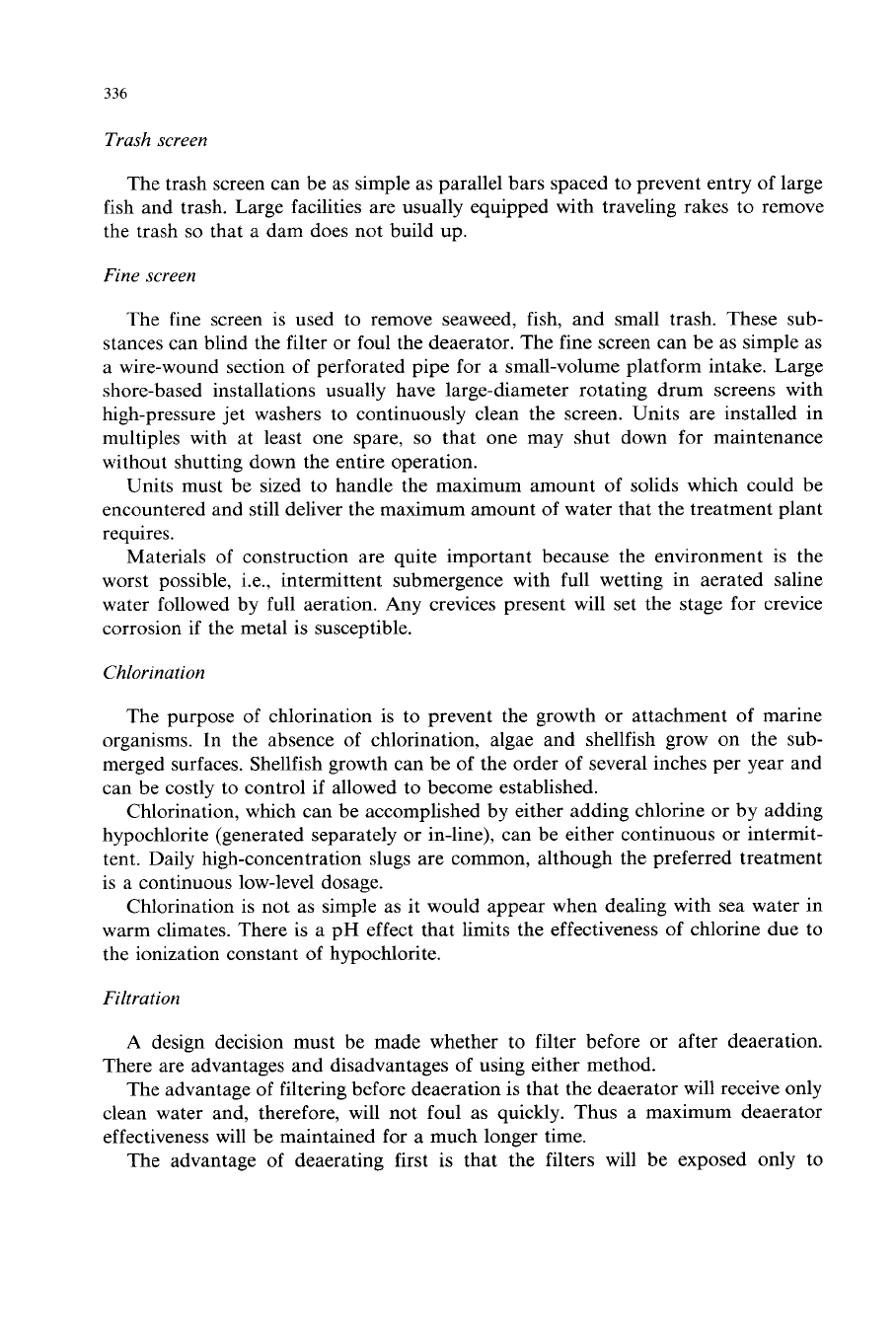
336
Trash screen
The trash screen can be as simple as parallel bars spaced to prevent entry of large
fish and trash. Large facilities are usually equipped with traveling rakes to remove
the trash
so
that a dam does not build up.
Fine screen
The fine screen is used to remove seaweed, fish, and small trash. These sub-
stances can blind the filter or foul the deaerator. The fine screen can be as simple as
a wire-wound section
of
perforated pipe for a small-volume platform intake. Large
shore-based installations usually have large-diameter rotating drum screens with
high-pressure jet washers to continuously clean the screen. Units are installed in
multiples with at least one spare,
so
that one may shut down for maintenance
without shutting down the entire operation.
Units must be sized to handle the maximum amount of solids which could be
encountered and still deliver the maximum amount of water that the treatment plant
requires.
Materials of construction are quite important because the environment is the
worst possible, i.e., intermittent submergence with full wetting in aerated saline
water followed by full aeration. Any crevices present will set the stage for crevice
corrosion if the metal
is
susceptible.
Chlorination
The purpose of chlorination is to prevent the growth or attachment
of
marine
organisms. In the absence of chlorination, algae and shellfish grow on the sub-
merged surfaces. Shellfish growth can be of the order of several inches per year and
can be costly to control if allowed to become established.
Chlorination, which can be accomplished by either adding chlorine or by adding
hypochlorite (generated separately or in-line), can be either continuous or intermit-
tent. Daily high-concentration slugs are common, although the preferred treatment
is a continuous low-level dosage.
Chlorination is not as simple as it would appear when dealing with sea water in
warm climates. There is a pH effect that limits the effectiveness of chlorine due to
the ionization constant of hypochlorite.
Filtration
A
design decision must be made whether to filter before or after deaeration.
There are advantages and disadvantages of using either method.
The advantage
of
filtering before deaeration is that the deaerator will receive only
clean water and, therefore, will not foul as quickly. Thus a maximum deaerator
effectiveness will be maintained for a much longer time.
The advantage of deaerating first is that the filters will be exposed only to
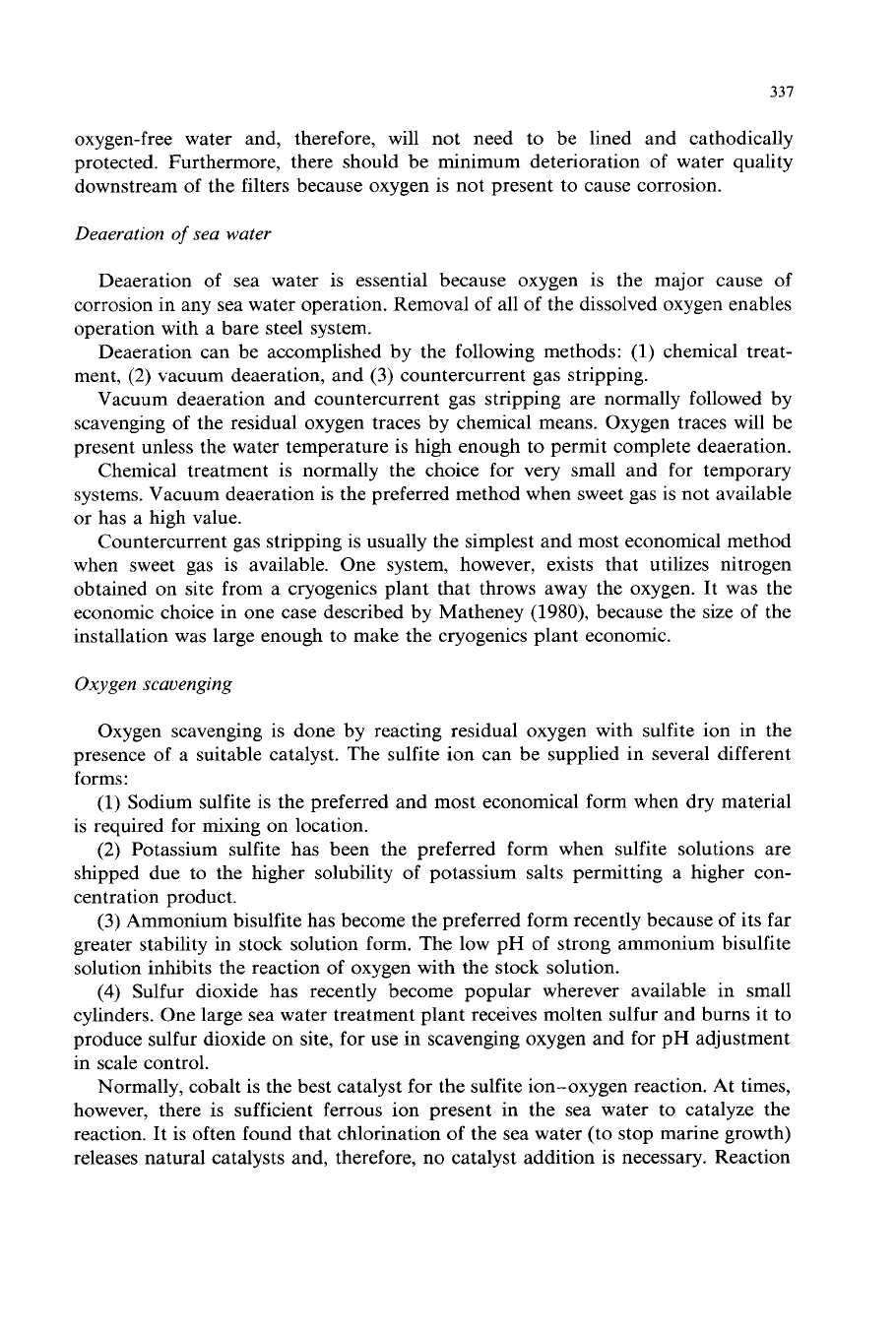
337
oxygen-free water and, therefore, will not need to be lined
and cathodically
protected. Furthermore, there should be minimum deterioration of water quality
downstream of the filters because oxygen is not present to cause corrosion.
Deaeration
of
sea water
Deaeration of sea water is essential because oxygen
is
the major cause of
corrosion in any sea water operation. Removal of all of the dissolved oxygen enables
operation with a bare steel system.
Deaeration can be accomplished by the following methods:
(1)
chemical treat-
ment,
(2)
vacuum deaeration, and
(3)
countercurrent gas stripping.
Vacuum deaeration and countercurrent gas stripping are normally followed by
scavenging of the residual oxygen traces by chemical means. Oxygen traces will be
present unless the water temperature is high enough to permit complete deaeration.
Chemical treatment is normally the choice for very small and for temporary
systems. Vacuum deaeration is the preferred method when sweet gas is not available
or has a high value.
Countercurrent gas stripping is usually the simplest and most economical method
when sweet gas is available. One system, however, exists that utilizes nitrogen
obtained on site from a cryogenics plant that throws away the oxygen. It was the
economic choice in one case described by Matheney
(1980),
because the size
of
the
installation was large enough to make the cryogenics plant economic.
Oxygen scavenging
Oxygen scavenging is done by reacting residual oxygen with sulfite ion in the
presence of a suitable catalyst. The sulfite ion can be supplied in several different
forms:
(1)
Sodium sulfite is the preferred and most economical form when dry material
is
required for mixing on location.
(2)
Potassium sulfite has been the preferred form when sulfite solutions are
shipped due to the higher solubility of potassium salts permitting a higher con-
centration product.
(3)
Ammonium bisulfite has become the preferred form recently because of its far
greater stability in stock solution form. The low pH of strong ammonium bisulfite
solution inhbits the reaction of oxygen with the stock solution.
(4)
Sulfur dioxide has recently become popular wherever available in small
cylinders. One large sea water treatment plant receives molten sulfur and burns it to
produce sulfur dioxide on site, for use in scavenging oxygen and for pH adjustment
in scale control.
Normally, cobalt is the best catalyst for the sulfite ion-oxygen reaction. At times,
however, there is sufficient ferrous ion present in the sea water to catalyze the
reaction. It is often found that chlorination
of
the sea water (to stop marine growth)
releases natural catalysts and, therefore, no catalyst addition is necessary. Reaction
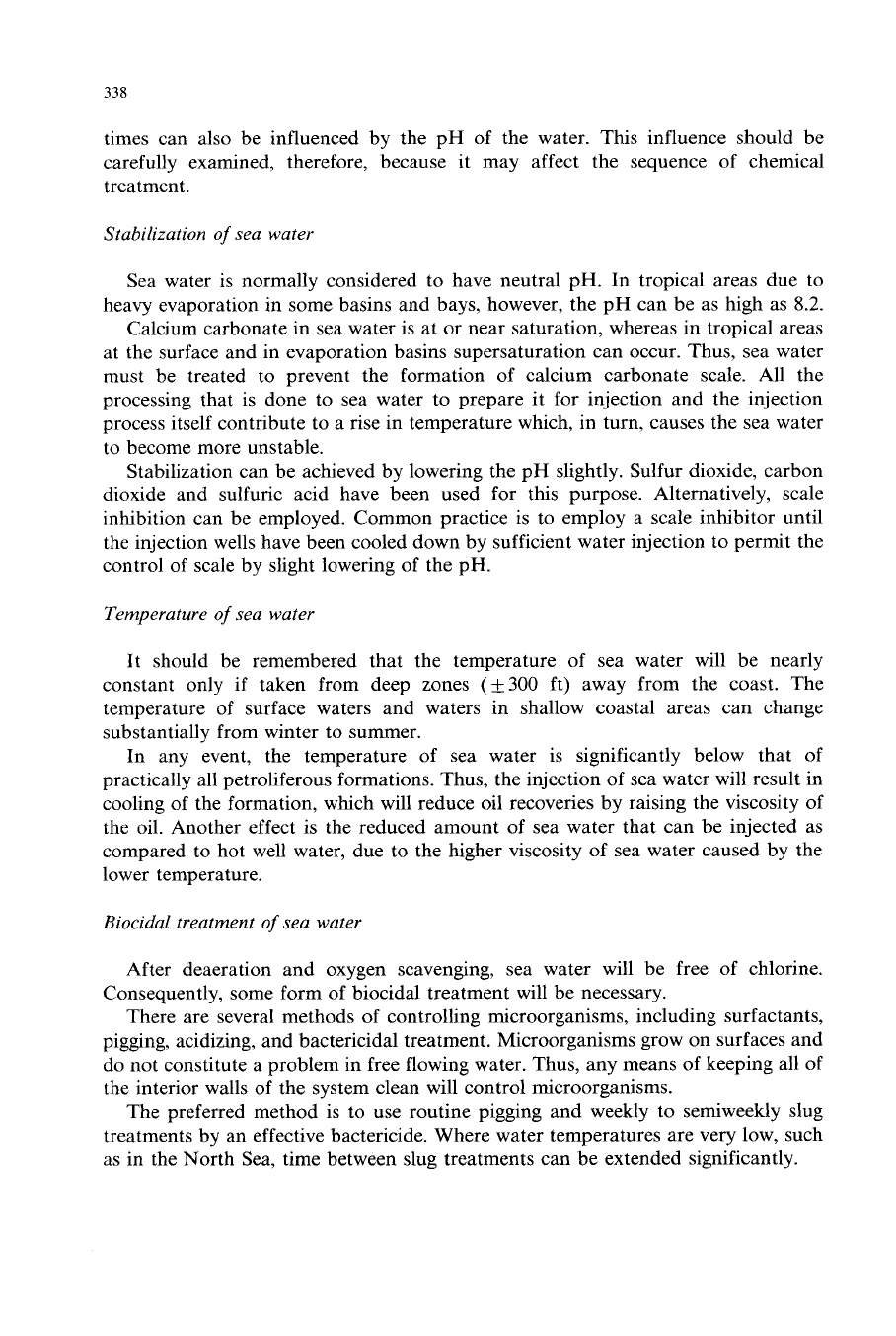
338
times can also be influenced by the pH of the water. This influence should be
carefully examined, therefore, because it may affect the sequence of chemical
treatment.
Stabilization
of
sea water
Sea water is normally considered to have neutral pH.
In
tropical areas due to
heavy evaporation in some basins and bays, however, the pH can be as high as
8.2.
Calcium carbonate in sea water is at or near saturation, whereas in tropical areas
at the surface and in evaporation basins supersaturation can occur. Thus, sea water
must be treated to prevent the formation of calcium carbonate scale. All the
processing that is done to sea water to prepare it for injection and the injection
process itself contribute to a rise in temperature which, in turn, causes the sea water
to become more unstable.
Stabilization can be achieved by lowering the pH slightly. Sulfur dioxide, carbon
dioxide and sulfuric acid have been used for this purpose. Alternatively, scale
inhibition can be employed. Common practice is to employ a scale inhibitor until
the injection wells have been cooled down by sufficient water injection to permit the
control
of
scale by slight lowering of the pH.
Temperature
of
sea water
It should be remembered that the temperature of sea water will be nearly
constant only if taken from deep zones
(+300
ft) away from the coast. The
temperature of surface waters and waters in shallow coastal areas can change
substantially from winter to summer.
In any event,
the temperature of sea water is significantly below that of
practically all petroliferous formations. Thus, the injection of sea water will result in
cooling of the formation, which will reduce oil recoveries by raising the viscosity of
the oil. Another effect is the reduced amount of sea water that can be injected as
compared to hot well water, due to the higher viscosity
of
sea water caused by the
lower temperature.
Biocidal treatment
of
sea water
After deaeration and oxygen scavenging, sea water will be free of chlorine.
Consequently, some form of biocidal treatment will be necessary.
There are several methods
of
controlling microorganisms, including surfactants,
pigging, acidizing, and bactericidal treatment. Microorganisms grow on surfaces and
do not constitute a problem in free flowing water. Thus, any means of keeping all of
the interior walls of the system clean will control microorganisms.
The preferred method is to use routine pigging and weekly to semiweekly slug
treatments by an effective bactericide. Where water temperatures are very low, such
as in the North Sea, time between slug treatments can be extended significantly.
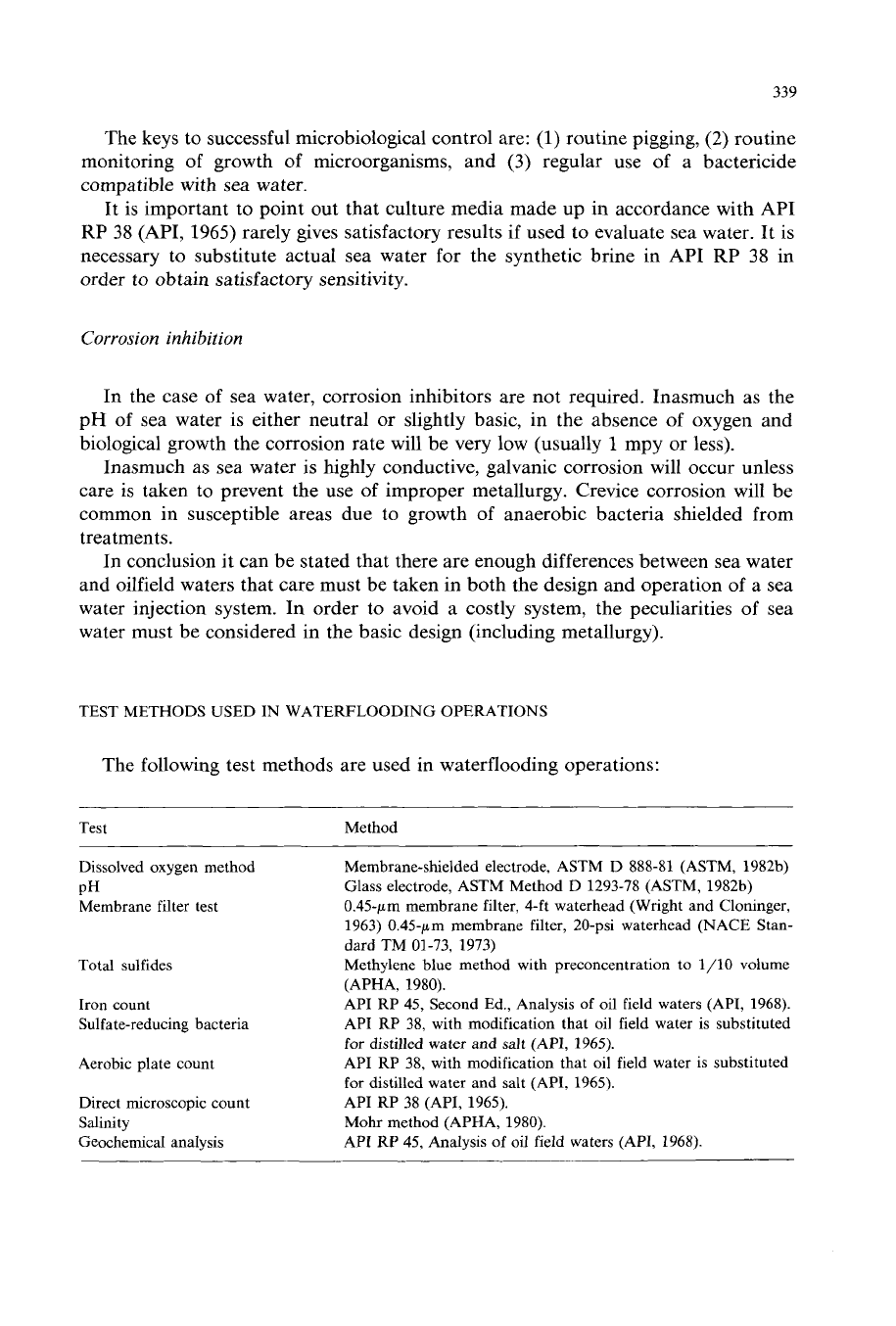
339
The keys to successful microbiological control are:
(1)
routine pigging,
(2)
routine
monitoring of growth of microorganisms, and
(3)
regular use of a bactericide
compatible with sea water.
It is important to point out that culture media made up in accordance with API
RP
38
(API,
1965)
rarely gives satisfactory results
if
used to evaluate sea water. It is
necessary to substitute actual sea water for the synthetic brine in API
RP
38
in
order
to
obtain satisfactory sensitivity.
Corrosion inhibition
In the case of sea water, corrosion inhibitors are not required. Inasmuch as the
pH
of sea water is either neutral or slightly basic, in the absence
of
oxygen and
biological growth the corrosion rate will be very low (usually
1
mpy or less).
Inasmuch as sea water
is
hghly conductive, galvanic corrosion will occur unless
care is taken to prevent the use of improper metallurgy. Crevice corrosion will be
common in susceptible areas due to growth
of
anaerobic bacteria shielded from
treatments.
In conclusion it can be stated that there are enough differences between sea water
and oilfield waters that care must be taken in both the design and operation of a sea
water injection system. In order to avoid a costly system, the peculiarities of sea
water must be considered in the basic design (including metallurgy).
TEST METHODS USED IN WATERFLOODING OPERATIONS
The following test methods are used in waterflooding operations:
Test Method
Dissolved oxygen method
Membrane filter test
PH
Total sulfides
Iron count
Sulfate-reducing bacteria
Aerobic plate count
Direct microscopic count
Salinity
Geochemical analysis
Membrane-shielded electrode, ASTM
D
888-81 (ASTM, 1982b)
Glass electrode, ASTM Method
D
1293-78 (ASTM, 1982b)
0.45-pm membrane filter, 4-ft waterhead (Wright and Cloninger,
1963) 0.45-pm membrane filter, 20-psi waterhead (NACE Stan-
dard
TM
01-73, 1973)
Methylene
blue
method with preconcentration
to
1/10 volume
(APHA, 1980).
API RP 45, Second Ed., Analysis of oil field waters (API, 1968).
API RP 38, with modification that oil field water is substituted
for distilled water and salt (API, 1965).
API RP 38, with modification that oil field water is substituted
for distilled water and salt (API, 1965).
API RP 38 (API, 1965).
Mohr method (APHA, 1980).
API RP
45,
Analysis
of
oil field waters (APJ, 1968).
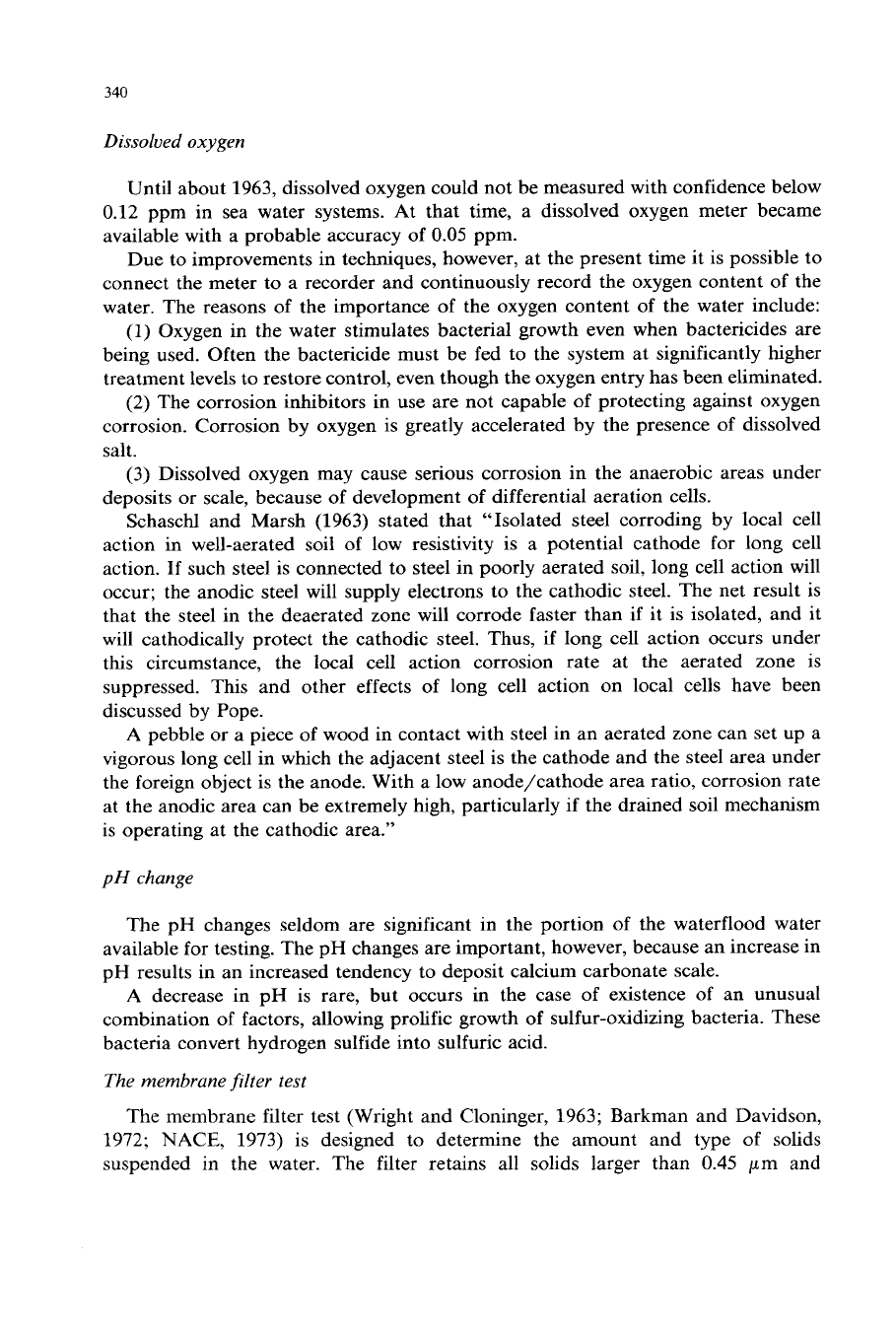
340
Dissolved
oxygen
Until about 1963, dissolved oxygen could not be measured with confidence below
0.12 ppm in sea water systems. At that time, a dissolved oxygen meter became
available with a probable accuracy of
0.05
ppm.
Due to improvements in techniques, however, at the present time it is possible to
connect the meter to a recorder and continuously record the oxygen content of the
water. The reasons
of
the importance of the oxygen content of the water include:
(1)
Oxygen in the water stimulates bacterial growth even when bactericides are
being used. Often the bactericide must be fed to the system at significantly higher
treatment levels to restore control, even though the oxygen entry has been eliminated.
(2)
The corrosion inhibitors in use are not capable of protecting against oxygen
corrosion. Corrosion by oxygen is greatly accelerated by the presence
of
dissolved
salt.
(3) Dissolved oxygen may cause serious corrosion in the anaerobic areas under
deposits or scale, because of development
of
differential aeration cells.
Schaschl and Marsh (1963) stated that “Isolated steel corroding by local cell
action in well-aerated soil of low resistivity is a potential cathode for long cell
action. If such steel is connected to steel in poorly aerated soil, long cell action will
occur; the anodic steel will supply electrons to the cathodic steel. The net result is
that the steel in the deaerated zone will corrode faster than
if
it is isolated, and it
will cathodically protect the cathodic steel. Thus,
if
long cell action occurs under
this circumstance, the local cell action corrosion rate at the aerated zone is
suppressed.
This
and other effects of long cell action on local cells have been
discussed by Pope.
A
pebble or a piece of wood in contact with steel in an aerated zone can set up a
vigorous long cell in which the adjacent steel is the cathode and the steel area under
the foreign object is the anode. With a low anode/cathode area ratio, corrosion rate
at the anodic area can be extremely high, particularly
if
the drained soil mechanism
is
operating at the cathodic area.”
pH
change
The pH changes seldom are significant in the portion
of
the waterflood water
available for testing. The pH changes are important, however, because an increase in
pH results in an increased tendency to deposit calcium carbonate scale.
A
decrease in pH is rare, but occurs in the case of existence of an unusual
combination
of
factors, allowing prolific growth of sulfur-oxidizing bacteria. These
bacteria convert hydrogen sulfide into sulfuric acid.
The membrane filter test
The membrane filter test (Wright and Cloninger, 1963; Barkman and Davidson,
1972; NACE, 1973) is designed to determine the amount and type
of
solids
suspended in the water. The filter retains all solids larger than
0.45
pm
and
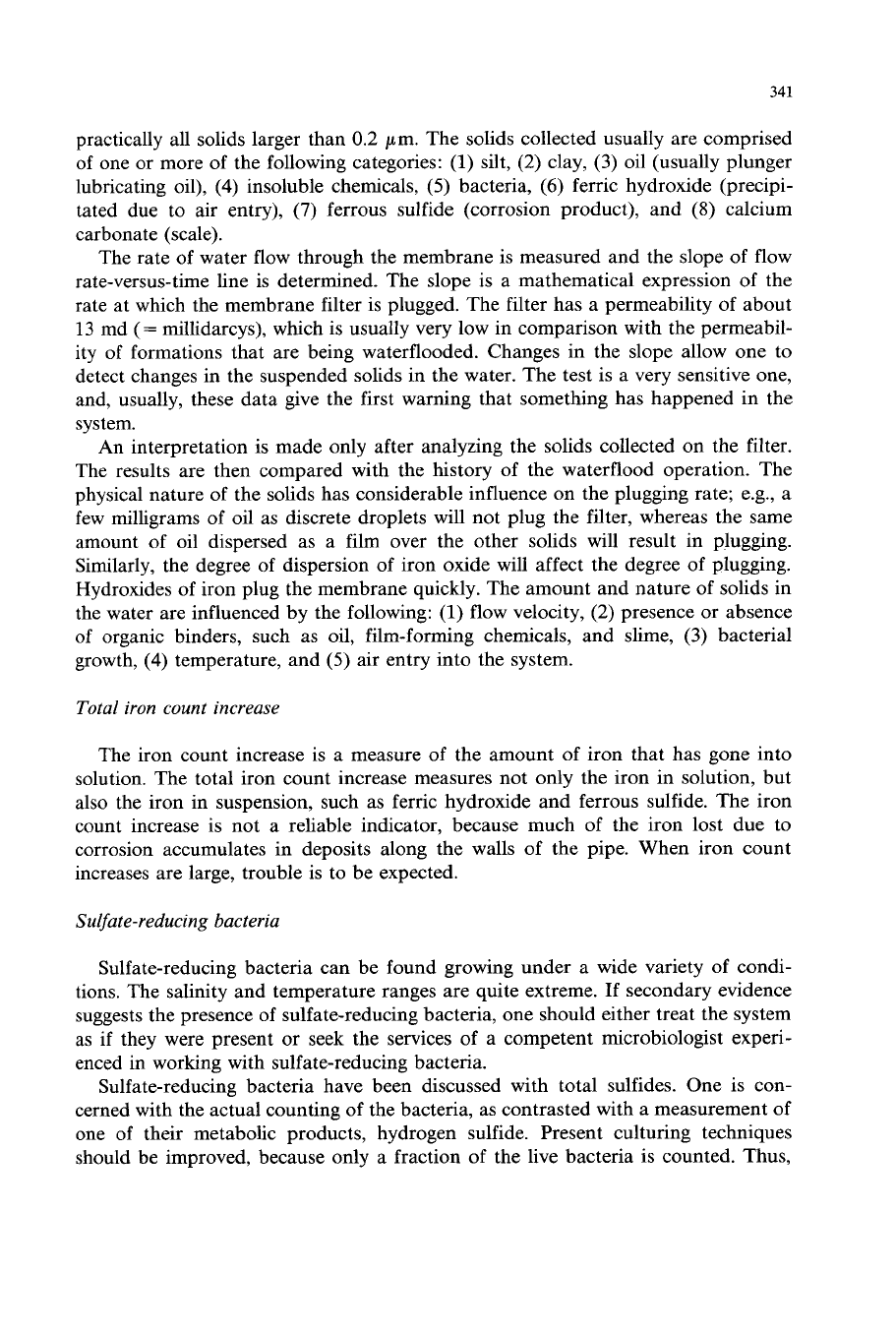
341
practically all solids larger than
0.2
pm. The solids collected usually are comprised
of one or more of the following categories:
(1)
silt,
(2)
clay,
(3)
oil (usually plunger
lubricating oil), (4) insoluble chemicals,
(5)
bacteria,
(6)
ferric hydroxide (precipi-
tated due to air entry),
(7)
ferrous sulfide (corrosion product), and
(8)
calcium
carbonate (scale).
The rate of water flow through the membrane is measured and the slope of flow
rate-versus-time line is determined. The slope is a mathematical expression of the
rate at which the membrane filter is plugged. The filter has a permeability
of
about
13
md
(=
millidarcys), which is usually very low in comparison with the permeabil-
ity of formations that are being waterflooded. Changes in the slope allow one to
detect changes in the suspended solids in the water. The test is a very sensitive one,
and, usually, these data give the first warning that something has happened in the
system.
An interpretation is made only after analyzing the solids collected on the filter.
The results are then compared with the history of the waterflood operation. The
physical nature of the solids has considerable influence on the plugging rate; e.g., a
few milligrams of oil as discrete droplets will not plug the filter, whereas the same
amount of oil dispersed as a film over the other solids will result in plugging.
Similarly, the degree of dispersion of iron oxide will affect the degree of plugging.
Hydroxides of iron plug the membrane quickly. The amount and nature of solids in
the water are influenced by the following:
(1)
flow velocity,
(2)
presence or absence
of organic binders, such as oil, film-forming chemicals, and slime,
(3)
bacterial
growth, (4) temperature, and
(5)
air entry into the system.
Total iron count increase
The iron count increase is a measure of the amount of iron that has gone into
solution. The total iron count increase measures not only the iron in solution, but
also the iron in suspension, such as ferric hydroxide and ferrous sulfide. The iron
count increase is not a reliable indicator, because much of the iron lost due to
corrosion accumulates in deposits along the walls of the pipe. When iron count
increases are large, trouble is to be expected.
Sulfate-reducing bacteria
Sulfate-reducing bacteria can be found growing under a wide variety
of
condi-
tions. The salinity and temperature ranges are quite extreme. If secondary evidence
suggests the presence of sulfate-reducing bacteria, one should either treat the system
as
if
they were present or seek the services of a competent microbiologist experi-
enced in working with sulfate-reducing bacteria.
Sulfate-reducing bacteria have been discussed with total sulfides. One is con-
cerned with the actual counting of the bacteria, as contrasted with a measurement of
one of their metabolic products, hydrogen sulfide. Present culturing techniques
should be improved, because only a fraction of the live bacteria is counted. Thus,
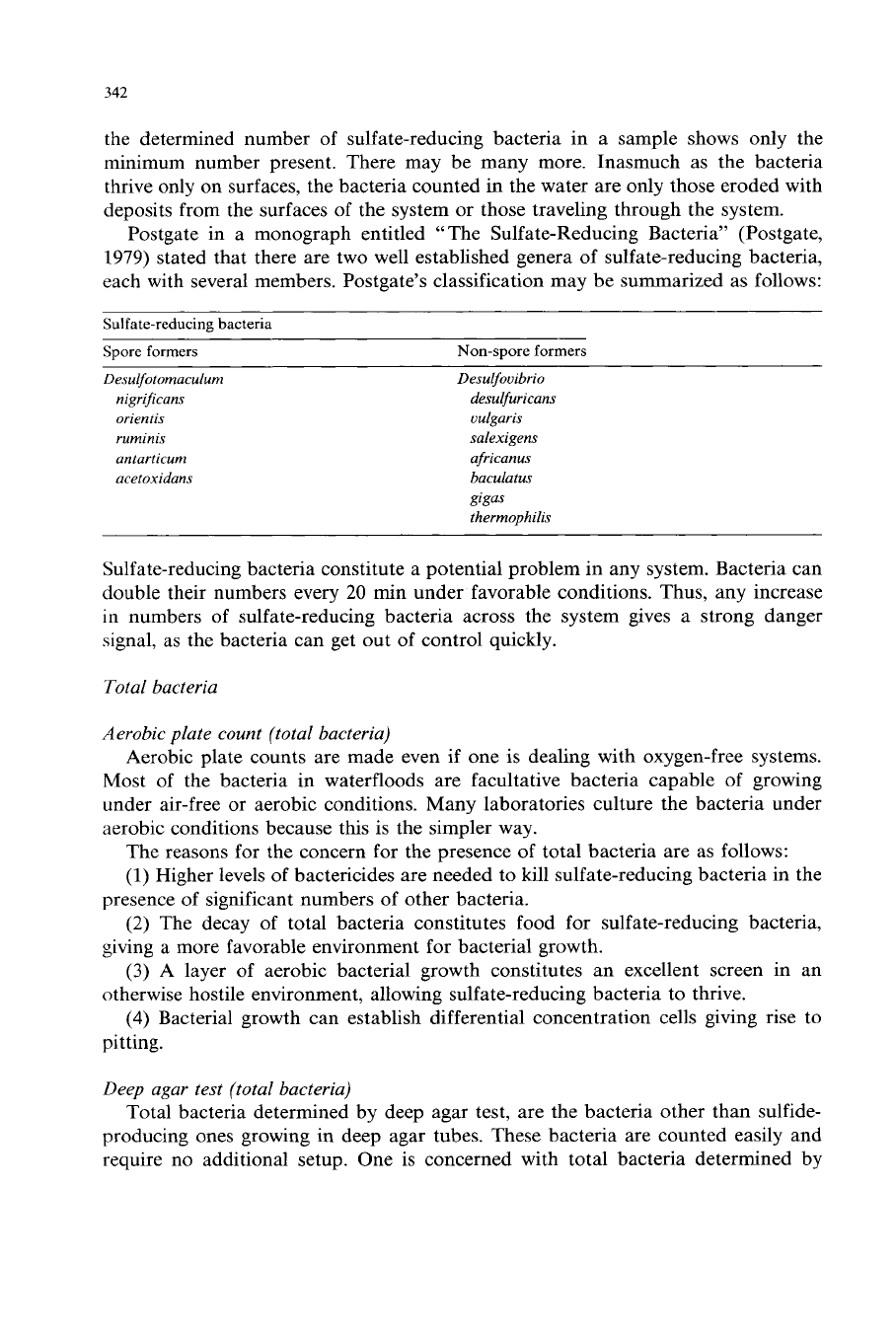
342
the determined number of sulfate-reducing bacteria in a sample shows only the
minimum number present. There may be many more. Inasmuch as the bacteria
thrive only on surfaces, the bacteria counted in the water are only those eroded with
deposits from the surfaces of the system or those traveling through the system.
Postgate in a monograph entitled “The Sulfate-Reducing Bacteria” (Postgate,
1979)
stated that there are two well established genera of sulfate-reducing bacteria,
each with several members. Postgate’s classification may be summarized as follows:
Sulfate-reducing bacteria
Spore
formers Non-spore formers
Desulfotomaculum
nigrificans
orientis
ruminis
antarticum
acetoxidans
Desulfouibrio
desulfiricans
uulgaris
salexigens
africanus
baculatus
giga
thermophilis
Sulfate-reducing bacteria constitute a potential problem in any system. Bacteria can
double their numbers every
20
min under favorable conditions. Thus, any increase
in numbers of sulfate-reducing bacteria across the system gives a strong danger
signal, as the bacteria can get out of control quickly.
Total bacteria
Aerobic plate count (total bacteria)
Aerobic plate counts are made even
if
one is dealing with oxygen-free systems.
Most of the bacteria in waterfloods are facultative bacteria capable of growing
under air-free or aerobic conditions. Many laboratories culture the bacteria under
aerobic conditions because this is the simpler way.
The reasons for the concern for the presence of total bacteria are as follows:
(1)
Higher levels of bactericides are needed to kill sulfate-reducing bacteria in the
(2)
The decay of total bacteria constitutes food for sulfate-reducing bacteria,
(3)
A layer of aerobic bacterial growth constitutes an excellent screen in an
(4)
Bacterial growth can establish differential concentration cells giving rise to
presence of significant numbers of other bacteria.
giving a more favorable environment
for
bacterial growth.
otherwise hostile environment, allowing sulfate-reducing bacteria to thrive.
pitting.
Deep
agar test (total bacteria)
Total bacteria determined by deep agar test, are the bacteria other than sulfide-
producing ones growing in deep agar tubes. These bacteria are counted easily and
require no additional setup. One is concerned with total bacteria determined by
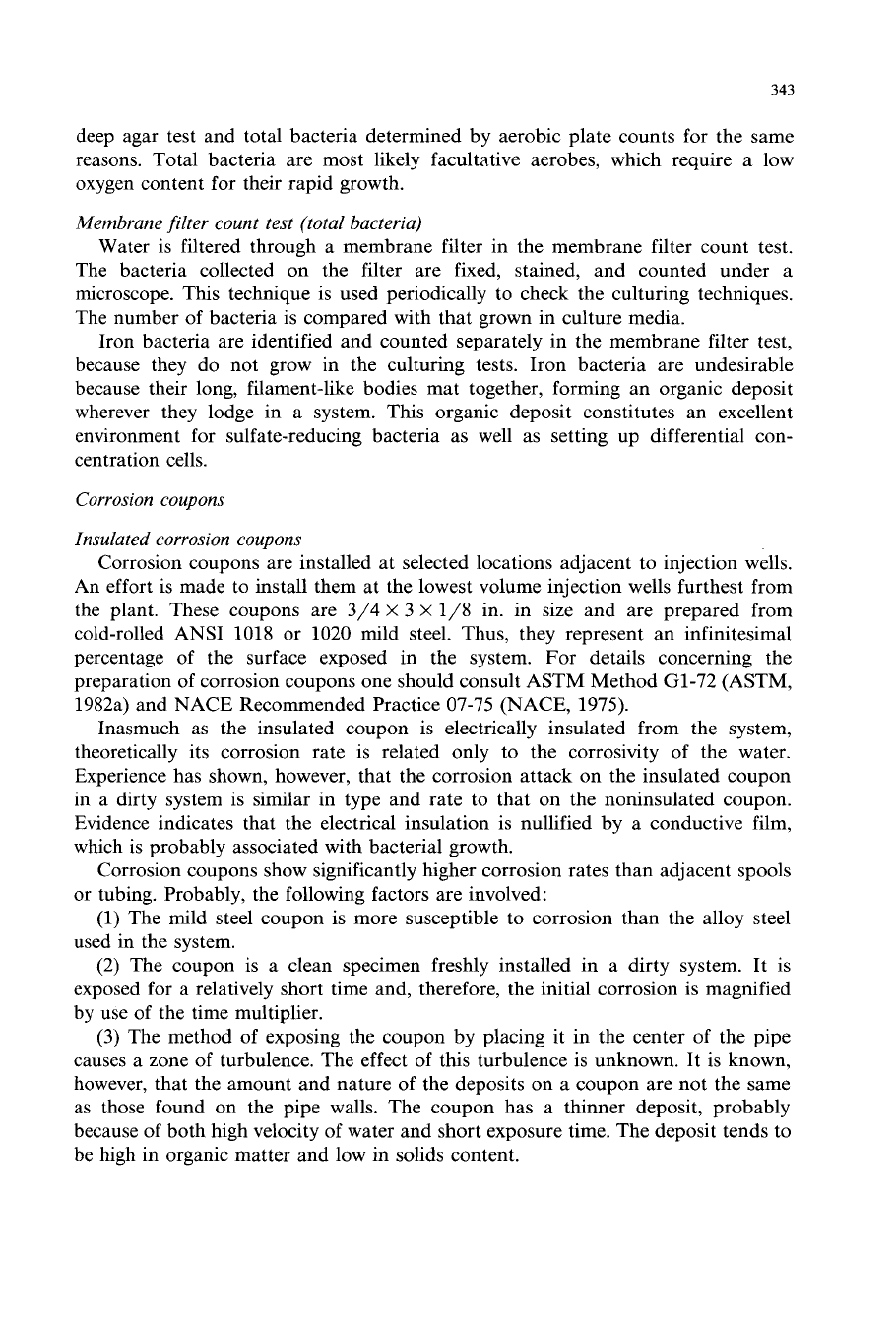
343
deep agar test and total bacteria determined by aerobic plate counts for the same
reasons. Total bacteria are most likely facultative aerobes, which require
a
low
oxygen content for their rapid growth.
Membrane filter count test (total bacteria)
Water is filtered through a membrane filter in the membrane filter count test.
The bacteria collected on the filter are fixed, stained, and counted under a
microscope. This technique is used periodically to check the culturing techniques.
The number of bacteria is compared with that grown in culture media.
Iron bacteria are identified and counted separately in the membrane filter test,
because they do not grow in the culturing tests. Iron bacteria are undesirable
because their long, filament-like bodies mat together, forming an organic deposit
wherever they lodge in a system. This organic deposit constitutes an excellent
environment for sulfate-reducing bacteria as well as setting up differential con-
centration cells.
Corrosion coupons
Insulated corrosion coupons
Corrosion coupons are installed at selected locations adjacent to injection wells.
An effort is made to install them at the lowest volume injection wells furthest from
the plant. These coupons are
3/4
X
3
X
1/8 in. in size and are prepared from
cold-rolled ANSI 1018 or 1020 mild steel. Thus, they represent an infinitesimal
percentage of the surface exposed in the system. For details concerning the
preparation of corrosion coupons one should consult ASTM Method G1-72 (ASTM,
1982a) and NACE Recommended Practice 07-75 (NACE, 1975).
Inasmuch as the insulated coupon is electrically insulated from the system,
theoretically its corrosion rate is related only to the corrosivity of the water.
Experience has shown, however, that the corrosion attack on the insulated coupon
in a dirty system is similar in type and rate to that on the noninsulated coupon.
Evidence indicates that the electrical insulation is nullified by a conductive film,
which is probably associated with bacterial growth.
Corrosion coupons show significantly higher corrosion rates than adjacent spools
or tubing. Probably, the following factors are involved:
(1) The mild steel coupon is more susceptible to corrosion than the alloy steel
used in the system.
(2) The coupon is a clean specimen freshly installed in a dirty system. It is
exposed for a relatively short time and, therefore, the initial corrosion is magnified
by use of the time multiplier.
(3)
The method of exposing the coupon by placing it in the center of the pipe
causes a zone of turbulence. The effect of this turbulence is unknown. It is known,
however, that the amount and nature of the deposits on a coupon are not the same
as those found on the pipe walls. The coupon has a thinner deposit, probably
because of both high velocity of water and short exposure time. The deposit tends to
be high in organic matter and low in solids content.
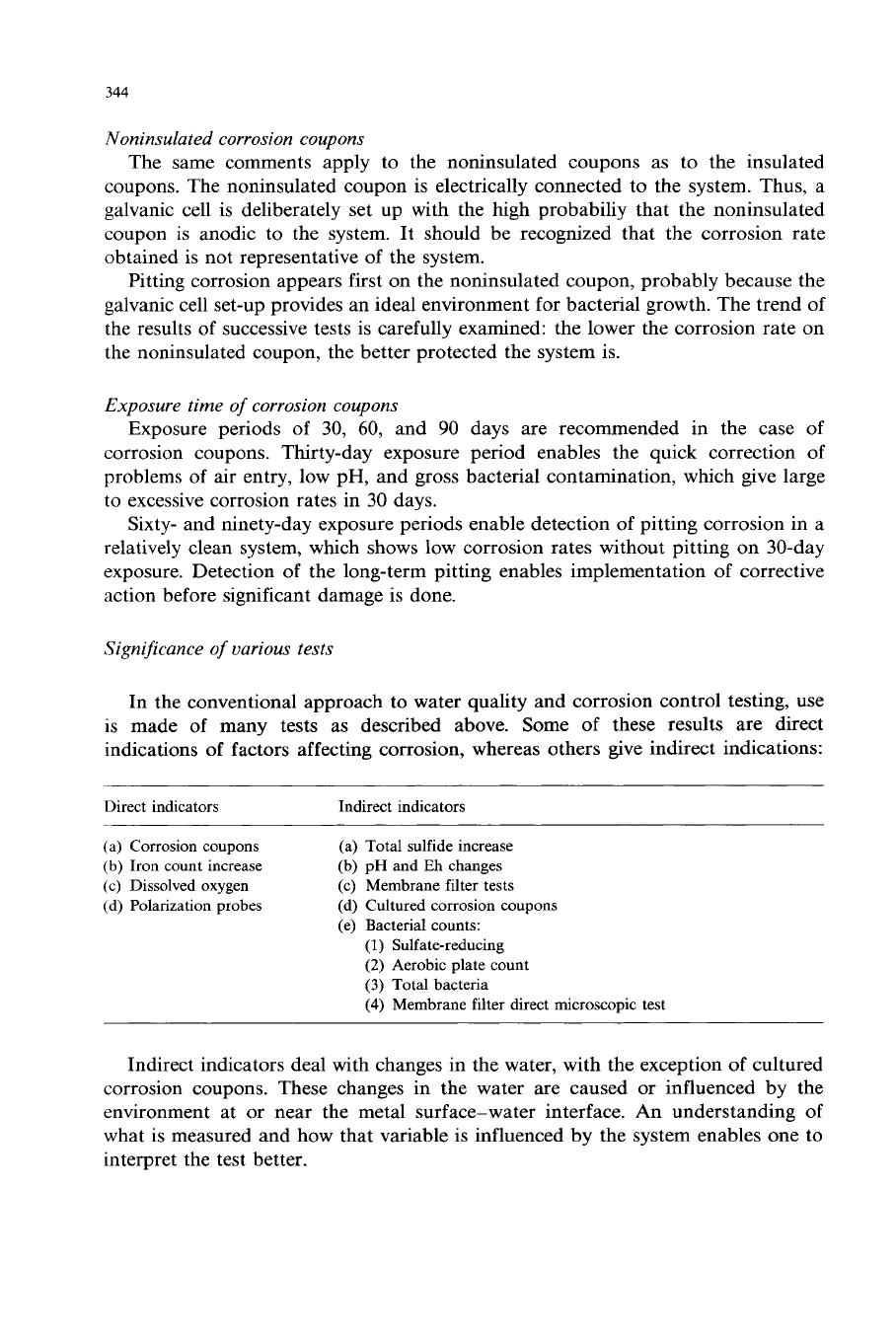
344
Noninsulated corrosion coupons
The same comments apply to the noninsulated coupons as to the insulated
coupons. The noninsulated coupon is electrically connected to the system. Thus, a
galvanic cell is deliberately set up with the high probabiliy that the noninsulated
coupon is anodic to the system. It should be recognized that the corrosion rate
obtained is not representative
of
the system.
Pitting corrosion appears first on the noninsulated coupon, probably because the
galvanic cell set-up provides an ideal environment for bacterial growth. The trend
of
the results
of
successive tests is carefully examined: the lower the corrosion rate on
the noninsulated coupon, the better protected the system is.
Exposure time
of
corrosion coupons
Exposure periods
of
30,
60,
and
90
days are recommended in the case of
corrosion coupons. Thirty-day exposure period enables the quick correction of
problems of air entry, low pH, and gross bacterial contamination, which give large
to excessive corrosion rates in 30 days.
Sixty- and ninety-day exposure periods enable detection of pitting corrosion in a
relatively clean system, which shows low corrosion rates without pitting on 30-day
exposure. Detection of the long-term pitting enables implementation
of
corrective
action before significant damage is done.
Significance
of
various tests
In the conventional approach to water quality and corrosion control testing, use
is made of many tests as described
above. Some
of
these results are direct
indications of factors affecting corrosion, whereas others give indirect indications:
Direct indicators Indirect indicators
~~~~ ~ ~ ~~
(a) Corrosion coupons
(b)
Iron count increase
(c)
Dissolved oxygen
(d)
Polarization probes
(a) Total sulfide increase
(b)
pH
and
Eh
changes
(c) Membrane filter tests
(d) Cultured corrosion coupons
(e) Bacterial counts:
(I)
Sulfate-reducing
(2) Aerobic plate count
(3)
Total bacteria
(4)
Membrane filter direct microscopic test
Indirect indicators deal with changes in the water, with the exception
of
cultured
corrosion coupons. These changes in the water are caused or influenced by the
environment at or near the metal surface-water interface. An understanding
of
what
is
measured and how that variable is influenced by the system enables one to
interpret the test better.
